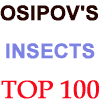Small Orange-Yellow Underwings: Wingspans: 50mm and under

| ** 8865
praeclara; Praeclara Underwing, (40-50mm);
The forewing is a pale greenish-grey with considerable contrasting
brown shading beyond post medial line.
There is a black basal dash very close to the inner margin and
another dash, higher up in the median area.
Note the contrasting shapes of the reniform and subreniform spots.
Tim Dyson image. |
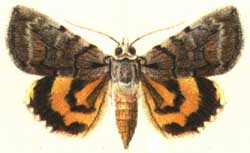
| ** 8865
praeclara manitoba; Manitoba Underwing, wingspan: 40-50mm
The forewing am line is black and distinct, oblique in its upper half and perpendicular to the inner margin
in its lower half. There is a distinct, narrow, white, toothed subterminal band.
The hindwing loop is complete.
|
Small-Medium Orange-Salmon Underwings: Wingspans: 65mm and under
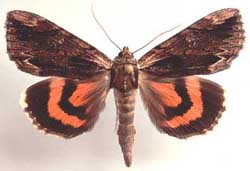
| ** 8857 Catocala ultronia;
Ultronia Underwing, wingspan: 50-63mm.
Fws typically gray-brown, with a distinct and very
dark inner margin and characteristic light brown patch, underscored
by very dark arc, near wingtip.
Underwings can be yellow to orange to salmon.
|
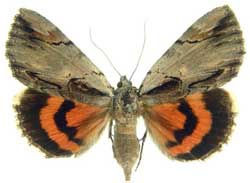
| ** 8857 Catocala ultronia form lucinda;
Ultronia Underwing, wingspan: 50-63mm.
In form lucinda most of the forewing
is bright grey. On all forms there is
extensive orange-salmon colouration on hw ventral surface,
and there is a dark discal lunule.
|
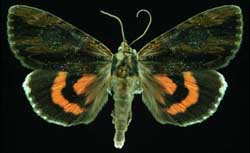
| Catocala ultronia,
form nigrescens, the Ultronia Underwing, wingspan: 50-63mm.
In the melanic form nigrescens, the dorsal forewing is very dark.
Even darker subapical arc, basal dash and dash near anal angle are still visible.
Dark basal hairs on hindwing.
Harold J. Vermes slide, used with permission from his son.
|
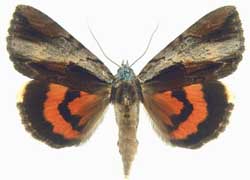
|
In form celia there is a wide, light grey band separating a dark region along inner margin and
a dark patch near the apex.
The ventral surface of forewings of all forms has a generous suffusion
of orange-salmon scales in the lower half of the median area.
|
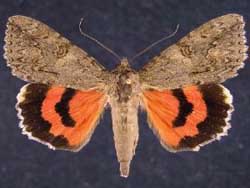
|
faustina;
58 mm
Forewing markings are relatively weak on almost uniform drab grey-brown ground colour.
The two middle "teeth" in the forewing postmedial line are relatively short.
The hindwing inner band is narrow and truncated well before the inner margin.
Black extenssions into white hindwing fringe continue as thin lines along veins. June until October; willows
|
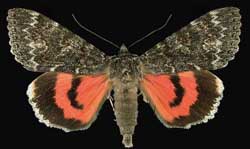
|
californica;
65mm.
Fws dark, gritty. Markings indistinct. Dark, large reniform spot; am and pm lines indistinct.
Subterminal line inwardly lined with light scales. Hw fringe white, checked halfway to outer edge with black,
black lines on veins extending through fringe. Some orange bleeding at apex. Black median band ends
well before im. June until August; willow or walnut??
|

| Catocala hermia;
Hermia Underwing: 58-68mm; pinkish:
Fw almost uniform, grey-brown or clay coloured; thin, yet contrasting lines.
Distinct large double reniform spot. Large concolourous subrenifrom spot usually open.
Hw pinkish red, relatively even, narrow black bands. Inner black band ends before im.
Fringe white, checked, pink/red "bleeding" along outer band, near apex.
|
Medium Orange-Salmon Underwings: Wingspans: 65mm - 75mm

| ** 8808 luciana;
Luciana Underwing; 57-70mm.
Luciana has pale grey brown fw with very distinct am
& pm lines.
Subreniform spot has elongated narrow "tail" that seems to
open through postmedial line.
Hw inner black band does not reach inner margin.
Fringe is checked and paler (almost yellow) than
salmon ground colour.
|
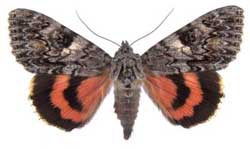
|
faustina allusa.
White interior outline of terminal line is typical of this species
and two jagged upper "teeth" of postmedial line are typical of most
poplar feeders. There is also a dark bar a few mm up from inner
margin of the forewing. Subreniform spot and area interior and above tend to be lighter. willows and poplars
|

| #8817 briseis;
Briseis Underwing;
60-70mm:
Fws predominantly mottled dark-grey-brown with some lighter areas between pm and subterminal lines, at base of am and pm lines along
im, and over subreniform spot running diagonally toward costa.
Pm lines lack greatly elongated and sharly pointed "teeth" near apex.
Hw fringe white, unbroken; inner black band (fairly even) reaches ima.
July-September, probably northern only; willows and poplars
|
Large Orange-Salmon Underwings: Wingspans: 65mm, usually 70-95mm

| ** 8821
semirelicta; Semirelict Underwing;
wingspan: 65-75mm.
Fw ground colour white with dark lines and shadings.
Diffuse dark bar runs from center of basal area to outer margin a
few mm above anal angle. Note regular dentation of st line.
Inner black bar on lower wing usually terminates well before
inner margin.
The form "atala" has forewing that is uniformly grey.
Unijuga is usually larger and has less contrasting black lines.
Inner black bar on unijuga usually reaches inner margin.
Tim Dyson image.
|

| ** 8822
meskei TM; Meske's Underwing;
65-75mm.
Fws less distinctly marked compared to unijuga,
some red-orange at the hindwing apex and just inside the
fringe along the outer margin in meskei that is lacking in unijuga.
Fw subreniform spot is opened or connected to the
postmedian line. The hindwing postmedian band nearly straight,
turned in and tapering near anal angle.
Tim Dyson image. |

| Catocala grotiana;
Grote's Underwing: 70-80mm unconfirmed, possibly southern:
White outlines outside postmedial and inside subterminal lines distinguish this species.
Hw inner black band is even and relatively thin and terminates well before the inner margin.
Fringe is heavily checked and charcoal grey along the inner margin.
Hws orange or red. August until September; willows
|
Large Orange-Salmon Underwings: Wingspans: 75mm and larger

| ** 8801
Catocala ilia; Ilia;
wingspan: 65-82mm.unconfirmed
Several different forms,
most have characteristic white area in and around
reniform spot. Diffuse dark arc running from this
spot to just below apex. Subreniform spot squarish, concave inner and outer edges
and elongated constriction connecting it to pml.
White dots near fw om in character
with the overall "contrasting" appearance.
|
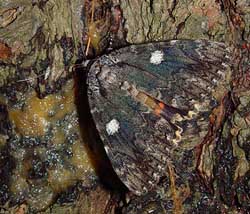
| ** 8801
Catocala ilia; Ilia;
form conspicua
In this form the entire reniform spot is heavily suffused with white scaling on
an otherwise darker ground colour. Hence the form name "conspicua".
Tim Dyson image. possibly in eastern Montana
|
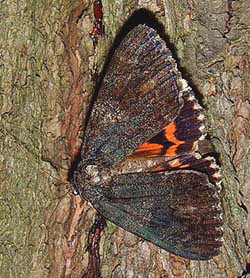
| ** 8801
Catocala ilia; Ilia;
form satanas
In this melanic form the entire forewing, including the reniform spot is very dark. Hence the form name "satanas".
The dark basal streak is still evident on this form.
Tim Dyson image.
|
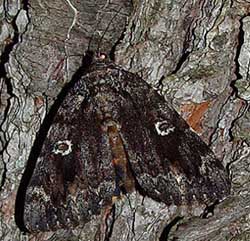
| ** 8801
Catocala ilia; Ilia;
form normani
In this semi-melanic form the entire forewing, excluding the reniform spot, is relatively dark.
The brownish, kidney-shaped center of the reniform spot is outlined in white.
The basal streak and subapical arc are still visible.
July until September, probably southeast; oaks
Tim Dyson image.
|

| Catocala junctura;
Joined Underwing; 67-85mm.
Fw is usually dark brownish-gray to evenly powdered
blue-grey w/o significant markings. Doubled reniform spot
often obscure. Thin, slightly darker am and pm
lines run from costa to im, not widely
spaced at im. Hw salmon/ orange-pink, narrow inner black band
turns in sharply, does not meet dark-haired im. May until October; poplars and willows
|

| ** 8798 Catocala neogama;
70-85mm. unconfirmed
Note brown head & thorax & larger size compared to
C. palaeogama.Slightly smaller
than subnata, Fws darker grey brown with
pronounced markings. Examination of hind tibia needed
for identification. Neogama's tend to be flattened,
unevenly, sparsely spined while subnata's tibia are cylindrical,
w spines dense, uniform in distribution.
Yellow-orange.
|

| ** 8805 unijuga;
Once-married; wingspan: 70-90mm: Catocala unijuga has a
fairly wide black inner band (almost reaching inner margin) in
hindwing and very distinctive patterning in forewing. Meskei tend to
have narrower band and dustier (less distinct) looking forewing.
Semirelicta tend to have inner bands that terminate well before
inner margins.
Also note the very white fringe on both the forewings and hindwings.
Carroll Rudy image.
|

| ** 8806 Catocala parta ??;
Mother Underwing, wingspan: 70-85mm.
The black dashes in the basal, subapical and anal areas help to
identify this species. The hindwings may be yellow to
yellowish-orange but more often are salmon-red. Note the
face-head-like markings on the thorax.
In the hindwing, the first (nearest the apex) black protrusion into
the white fringe is "noticeably" larger than the others.
|

| aholibah;
80-90mm: Fw is mix of grey and brown, with preponderance of brown in subterminal area.
Double reniform spot has diffuse brown outline of inner oval. Subreniform spot is small,
distinctly outlined in black,
light coloured and does not connect to pm line. Upper two teeth of pm line are elongate
and are followed by relatively smooth line til next tooth below the subreniform spot.
Hindwing salmon or pinkish. unconfirmed
|
Large Black Underwings (Banded): Wingspans: 70-80mm
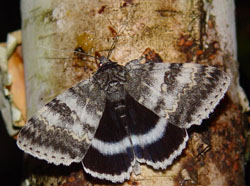
| ** 8803 Catocala relicta
;
Forsaken, White, Relict; 70-80mm:
Considerable variation with regard to black/white
concentrations on fws.
Typical specimens have basal and subterminal areas with
blackish scales.
Black hws, with brilliant even white inner band and
white fringe, are distinctive. June until October.
|

| ** 8803 Catocala relicta
;
Forsaken, White, Relict; 70-80mm:
Considerable variation with regard to black/white
concentrations on fws.
Form clara: basal and subterminal
areas predominantly white.
Typical specimens have basal and subterminal areas with
blackish scales. Black hws, with brilliant even white inner band and
white fringe, are distinctive. June until October.
|
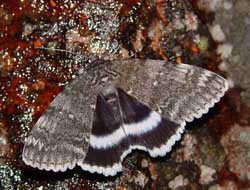
| ** 8803 Catocala relicta
;
Forsaken, White, Relict; 70-80mm:
Considerable variation with regard to black/white
concentrations on fws.
Form phrynia:
evenly dusted with grey over entire forewing.
Typical specimens have basal and subterminal areas with
blackish scales. Black hws, with brilliant even white inner band and
white fringe, are distinctive. June until October, poplars and willows
|
Large Pink Underwings

|
** 8834 amatrix
Sweetheart Underwing; (wingspan 75-95mm).
Very skittish, frequently hides in caves, under
bridges, under tree bark, etc. by day, resting with head down.
Hw patterning and colouration similar to that of
C. concumbens, but large size (wingspan 75-95mm)
and dark bar running from basal area to just below apex
distinguishes C. amatrix. See large
Catocala amatrix courtesy of
Joan F. Rickert.
|
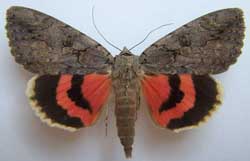
|
** 8834 amatrix form selecta
Sweetheart Underwing; (wingspan 75-95mm)
Very skittish and frequently hides in caves, under
bridges, under tree bark, etc. by day, resting with head down.
Several forms, including selecta (to the left)
which lacks dark bar on forewing. Hesseli: melanic form;
pallida: very pale form.
|
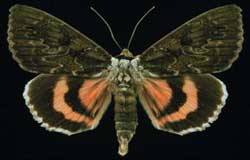
|
** 8834 amatrix form hesseli
Sweetheart Underwing; (wingspan 75-95mm)
Very skittish and frequently hides in caves, under
bridges, under tree bark, etc. by day, resting with head down.
The melanic form hesseli is very dark and displays dark basal hairs in the hindwing.
|
|

